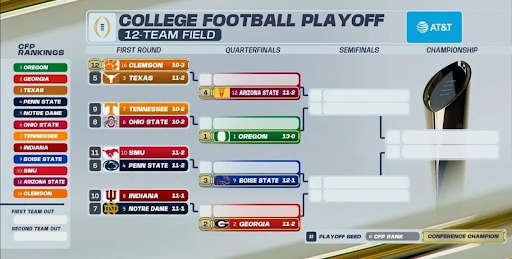The college football world is buzzing right now, and it’s not because of epic games or jaw-dropping touchdowns.
The 2024-2025 College Football Playoff (CFP) system has stirred up major drama, leaving fans and teams feeling all sorts of emotions.
Whether you’re a die-hard football fan or just someone who enjoys the occasional tailgate, this new playoff format has been the center of attention– and not always in a good way.
What’s New with the CFP system?
The 2024-2025 season marks the first time the College Football Playoff has expanded to 12 teams
Before, it was a simple four-team bracket: the top teams would battle it out in the semifinals, and the winners would head to the national championship game.
But with the new format, the CFP committee decided to add more teams to the mix, aiming to give smaller schools and underdogs a shot at the big stage.
Here’s how it works:
- The top four conference champions receive automatic bids and first-round byes.
- The next eight teams, chosen by a ranking committee, compete in the first round. This includes both conference champs and at-large teams.
- First-round games are played at the higher-seeded team’s home stadium. After that, it’s neutral-site bowl games leading to the championship.
On paper, this system sounds awesome. More teams mean more chances for upsets, underdog stories, and intense games. But, as always, not everything has gone smoothly.
Why Is It Controversial?
The new system might sound fair, but it’s already caused some serious drama.
The Alabama Crimson Tide, one of the most dominant teams in college football history, missed the playoffs despite going 9-3 and having multiple ranked wins including Georgia, South Carolina, and Missouri.
The open spot was taken by the SMU (Southern Methodist University) Mustangs, a team from a smaller conference.
SMU had a great season, but many people argued that their weaker schedule didn’t compare to Alabama’s grueling SEC matchups.
The Mustangs rank 75th for strength of schedule and lost to the two ranked teams they’ve played: BYU and Clemson.
“I think for the sake of talent, Alabama is a much better team and lost games against decent teams. SMU didn’t do anything all year and has less talent,” said Aaron Hannon, senior.
The CFP committee likely put SMU in over Alabama to avoid making a controversial decision like last year’s FSU.
Last year, FSU went undefeated, won the ACC, and looked like a lock for the CFP. But then the committee dropped a bombshell: they left FSU out of the top four because their starting quarterback got injured late in the season.
The committee claimed the team wasn’t “complete” enough without their QB, even though they hadn’t lost a game. Instead, one-loss teams like Alabama and Texas made it in, sparking outrage.
“I believe FSU deserved to be in the playoffs because they did everything they could do to be there,” said Hannon.
Fans and analysts called it a slap in the face to the idea that games are won on the field, not on paper.
How Could It Be Fixed?
So, what’s the problem? A lot of it boils down to how the teams make the playout. The committee uses a mix of stats, game results, and “eye tests” to rank teams, but there’s no clear formula. That leaves room for a lot of opinions — and controversy.
One solution people have suggested is to create a fully objective ranking system. Instead of a committee, teams could be ranked based on computer algorithms, like the old BCS system used to do.
These rankings could factor in strength of schedule, point margins, and other stats to make the process less biased.
Another idea is to adjust automatic bids. Right now, conference champions automatically qualify, even if their conference isn’t super competitive.
Critics argue that only the best teams, regardless of conference, should make the playoffs. That way, teams like Alabama wouldn’t get snubbed in favor of smaller schools with weaker resumes.
Lastly, some people want to increase the number of teams even more — maybe to 16 teams. This would give more room for big-name programs and Cinderella stories alike, hopefully reducing the chances of someone feeling left out.
Why Does It Matter?
At the end of the day, college football is about more than just trophies and rankings. It’s about the fans, the players, and the passion that comes with every game.
When teams like FSU or Alabama are left out, it feels like the system is broken, frustrating everyone involved.
This new playoff format was supposed to make things better, but instead, it’s raised more questions than answers. Is it fair? Should teams be judged on their season-long performance or how they look in December? And how much weight should smaller schools — those with a smaller brand and competition — be given when competing with powerhouse programs?
For now, the 12-team CFP is here to stay, and while it’s definitely exciting, it’s also clear that there is room for improvement.
Whether you’re cheering for a big-name team or rooting for the underdog, one thing’s for sure: college football is as unpredictable — and controversial — as ever.

My name is Andrew, and I will produce the most entertaining content for my fans. I will write about anything and everything. (Trust me I’ve tested it.)

Leave a Reply